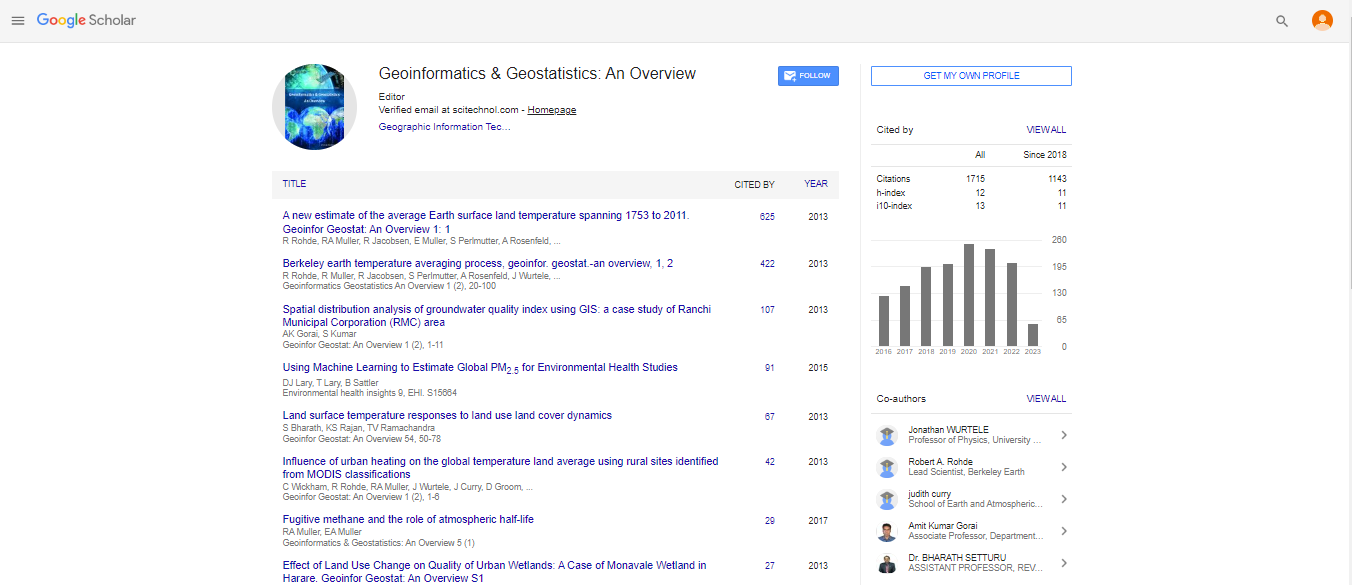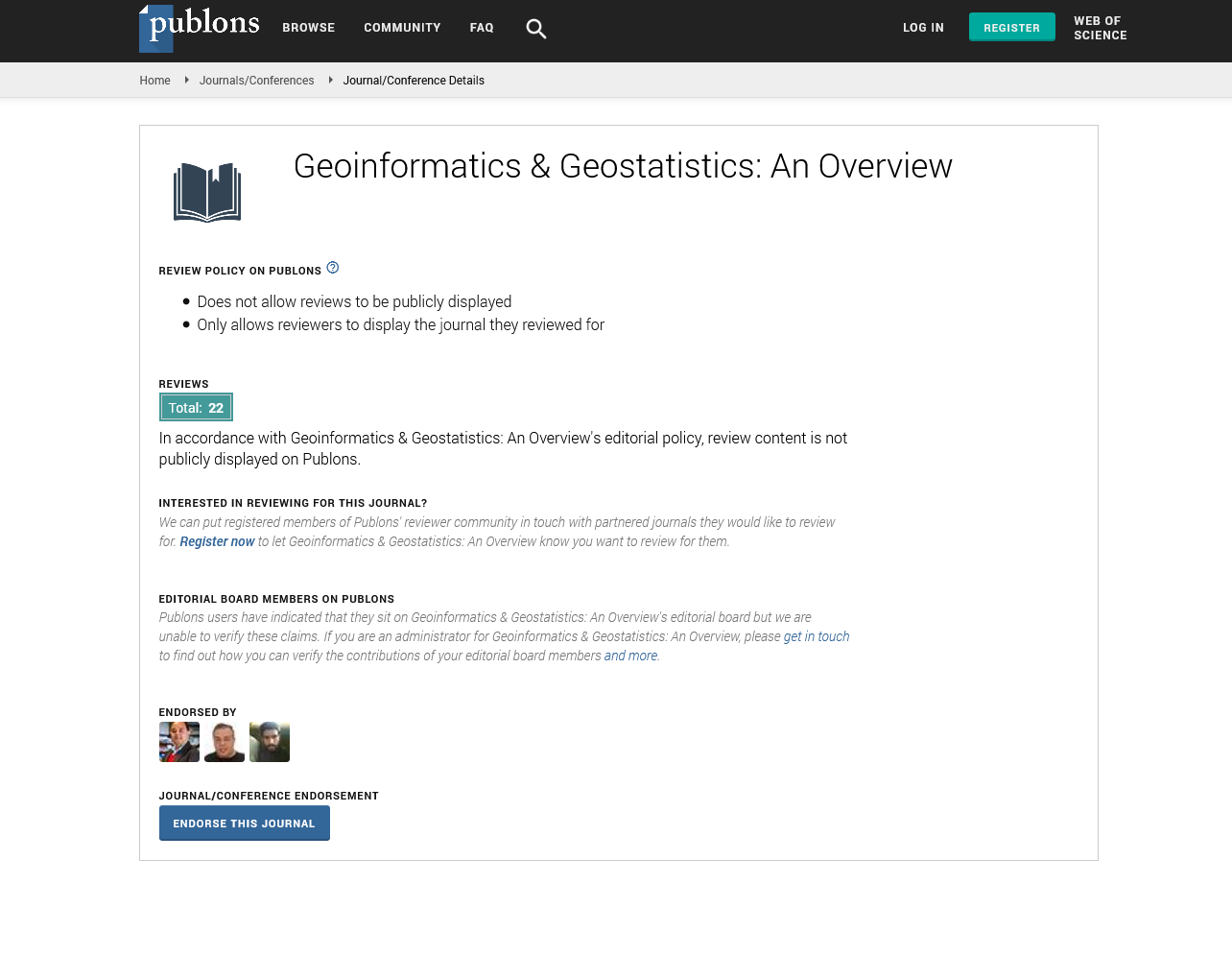Perspective, Geoinfor Geostat An Overview Vol: 12 Issue: 6
Geospatial Technologies and their Impact on Spatial Data Analysis
Lan Zenel*
1Department of Geology, Czech University, Prague, Czech Republic
*Corresponding Author: Lan Zenel,
Department of Geology, Czech University,
Prague, Czech Republic
E-mail: Lz573@tfczu.cz
Received date: 25 November, 2024, Manuscript No. GIGS-24-156230;
Editor assigned date: 27 November, 2024, PreQC No. GIGS-24-156230 (PQ);
Reviewed date: 11 December, 2024, QC No. GIGS-24-156230;
Revised date: 18 December, 2024, Manuscript No. GIGS-24-156230 (R);
Published date: 26 December, 2024, DOI: 10.4172/2327-4581.1000425.
Citation: Zenel L (2024) Geospatial Technologies and their Impact on Spatial Data Analysis. Geoinfor Geostat: An Overview 12:6.
Description
Geospatial technologies encompass a wide range of tools, techniques systems that enable the collection, analysis visualization of geographic data. These technologies have revolutionized the way we understand the Earth’s surface and how we make decisions based on spatial data. With advancements in Geographic Information Systems (GIS), remote sensing Global Positioning Systems (GPS), geospatial technologies are increasingly used in various sectors, including environmental management, urban planning, transportation, agriculture disaster management. They offer the ability to map, analyze interpret spatial data to make informed decisions, providing essential visions into phenomena that are spatially distributed across landscapes.
The core of geospatial technologies is the integration of data that describes the location and attributes of objects on the Earth’s surface. GIS is perhaps the most widely recognized tool in geospatial technologies, offering a framework for collecting, storing, analyzing visualizing spatial and geographic data. GIS combines layers of data from various sources, allowing users to visualize, query analyze spatial relationships and patterns. It can integrate data from satellite imagery, aerial photography, census records, environmental sensors other sources. GIS allows users to perform tasks such as mapping topography, analyzing population distribution identifying patterns of land use change. Remote sensing, another fundamental geospatial technology, involves the acquisition of data from the Earth’s surface using satellite and airborne sensors. Remote sensing technologies provide vital information about the Earth’s physical characteristics, including vegetation cover, temperature water bodies. These data are important for monitoring environmental changes, land use natural resource management.
GPS, the third pillar of geospatial technologies, enables precise location tracking and navigation. GPS is used to determine the exact position of objects or individuals on Earth, facilitating tasks such as route planning, asset management real-time tracking. With applications ranging from personal navigation devices to fleet management systems and precision agriculture, GPS has become integral to both daily life and specialized industries. By combining GIS, remote sensing GPS, geospatial technologies allow for comprehensive spatial analysis and provide major tools for decisionmaking in a range of fields.
One of the most prominent applications of geospatial technologies is in urban planning. GIS is used by city planners to design infrastructure; plan transportation networks assess the impact of land use decisions. It enables planners to model future growth, optimize resource allocation assess the environmental and social impacts of various development strategies. Remote sensing plays a vital role in monitoring urban sprawl and tracking land-use changes over time. For instance, satellite images provide data on urban expansion, helping municipalities understand how cities grow and plan for sustainable development. Geospatial technologies also help in managing transportation systems, optimizing routes reducing congestion by analyzing traffic patterns and real-time data.
Agriculture has also benefited greatly from the integration of geospatial technologies. Precision agriculture, which utilizes GPS and GIS tools, allows farmers to optimize crop yields, monitor soil health manage water resources more efficiently. Through satellite imagery and remote sensing, farmers can assess the health of their crops, detect early signs of pest infestations adjust irrigation and fertilization practices. GPS-guided tractors and harvesters also improve efficiency by reducing overlap in planting and harvesting, thereby conserving resources and minimizing environmental impact.
In environmental management, geospatial technologies are indispensable for monitoring and conserving natural resources. GIS and remote sensing are used to track deforestation, monitor biodiversity study climate change. For example, satellite images help researchers assess the health of forests, detect illegal logging activities evaluate the effectiveness of conservation efforts. In disaster management, geospatial technologies are important for risk assessment, response planning recovery efforts. GIS is used to identify areas prone to flooding, earthquakes, or wildfires, enabling authorities to allocate resources effectively and plan evacuations. During a disaster, real-time data from remote sensing and GPS can be used to coordinate rescue operations and provide major situational awareness.
Geospatial technologies are also increasingly used in the field of public health. GIS is used to map the distribution of diseases and identify factors that influence their spread. During outbreaks, such as the COVID-19 pandemic, geospatial data has been important in tracking the spread of the virus, predicting hot spots implementing targeted interventions. Health authorities use GIS to determine areas with higher risks of infection and deploy resources accordingly. Similarly, geospatial data aids in understanding environmental health risks, such as exposure to pollution or the proximity to hazardous sites.
In conclusion, geospatial technologies have transformed how we collect, analyze utilize spatial data. By integrating GIS, remote sensing GPS, these technologies provide major visions into a wide range of the sectors, from urban planning to disaster management. As the tools and technologies continue to evolve, their potential for improving decisionmaking and addressing complex global challenges will only grow. The continued development and application of geospatial technologies will play an essential role in shaping sustainable and resilient societies.
 Spanish
Spanish  Chinese
Chinese  Russian
Russian  German
German  French
French  Japanese
Japanese  Portuguese
Portuguese  Hindi
Hindi 
